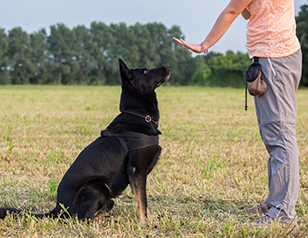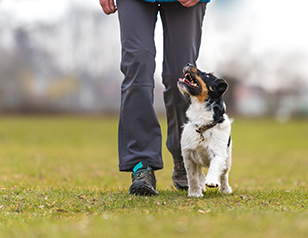Top 10 Dog Obedience Commands Every Pet Should Know
Dog obedience training is crucial for ensuring a well-behaved and happy pet. Mastering basic commands improves your dog’s behaviour and strengthens the bond between you and your furry friend. Effective training enhances communication, leading to a more harmonious relationship.
Sit
Why It’s Important
“Sit” is a foundational command that establishes control and promotes calm behaviour. It helps prevent jumping, provides a way to redirect your dog’s focus, and can be used to manage behaviour in various situations, such as when greeting guests or before feeding. Mastering “sit” sets the stage for more advanced commands, reinforcing your role as the leader and making further training easier.
How to Teach
- Step-by-step Instructions:
- Hold a treat close to your dog’s nose.
- Move your hand up, allowing their head to follow the treat, causing their bottom to lower.
- Once sitting, say “Sit,” give them the treat, and praise them.
- Practice Tips::
- Practice in various environments to ensure your dog responds consistently.
- Use the command before meals, during walks, and other daily routines to reinforce the behaviour.
Stay
Why It’s Important
“Stay” is crucial for safety and control, ensuring your dog remains in place regardless of distractions or temptations. It is particularly useful in potentially dangerous situations, like busy streets or crowded areas. Additionally, “stay” teaches patience and impulse control, contributing to overall good behaviour and making it easier to manage your dog in public places or at home.
How to Teach
- Step-by-step Instructions::
- Start with your dog in a sitting position.
- Open your palm in front of you and say, “Stay.”
- Take a few steps back, then return and reward with a treat.
- Practice Tips::
- Gradually increase the distance and duration, ensuring your dog remains in place.
- Practice in different settings with varying levels of distractions to reinforce the command.
Come
Why It’s Important
A reliable recall command like “come” is essential for your dog’s safety, particularly during off-leash activities or emergencies. It ensures your dog will return to you when called, reducing the risk of accidents or getting lost. “Come” also strengthens the bond between you and your dog, reinforcing trust and your role as the leader.
How to Teach
- Step-by-step Instructions::
- Put a leash on your dog and let them wander a bit.
- Say “Come” while gently pulling the leash towards you.
- Reward them with treats and praise when they reach you.
- Practice Tips::
- Make the command fun by using an excited tone and offering high-value rewards.
- Practice in safe, enclosed areas before progressing to more open spaces.
Heel
Why It’s Important
“Heel” is essential for maintaining control during walks, especially in public places. It ensures your dog walks calmly beside you without pulling on the leash, making walks more enjoyable and safer for both of you. This command is essential for dogs that tend to be reactive or overly excited, as it helps maintain focus and reduces unwanted behaviours.
How to Teach
- Step-by-step Instructions::
- With your dog on a leash, start walking and say, “Heel.”
- Reward your dog for walking beside you without pulling.
- Practice Tips::
- Use treats and praise to maintain focus and encourage calm walking.
- Practice in different environments, gradually increasing distractions.
Down
Why It’s Important
The “down” command helps manage your dog’s energy and keeps them calm in various situations, such as during vet visits or when guests are over. It is useful for promoting relaxation and preventing jumping or other excitable behaviours. Teaching “down” also provides a basis for further training and helps manage situations where calm behaviour is required.
How to Teach
- Step-by-step Instructions::
- Hold a treat in your closed hand and move it to the ground.
- When your dog follows the treat, say “Down.”
- Reward and praise once your dog is in the lying position.
- Practice Tips::
- Practice regularly to reinforce the command.
- Use this command to help your dog settle in various situations.
Leave It
Why It’s Important
“Leave it” is crucial for preventing your dog from picking up harmful objects or food, ensuring their safety. This command helps to avoid dangerous situations, such as ingesting toxic substances or choking hazards. It also teaches impulse control and reinforces leadership, making it easier to manage your dog in various environments.
How to Teach
- Step-by-step Instructions::
- Hold a treat in both hands, show one hand with the treat, and say, “Leave it.”
- When your dog ignores the treat, reward them with the treat from the other hand.
- Practice Tips::
- Practice with different objects to generalize the behaviour.
- Gradually increase the difficulty by introducing distractions.
Drop It
Why It’s Important
The “drop it” command is essential if your dog picks up something dangerous, ensuring they release it immediately. This command can prevent choking, poisoning, or ingestion of harmful objects. It also promotes safe play by teaching your dog to release toys or other items on command, making interactions more enjoyable and controlled.
How to Teach
- Step-by-step Instructions::
- Offer your dog a toy to hold.
- Say “Drop it” while holding a treat near their nose.
- When they release the toy, reward them with the treat.
- Practice Tips::
- Practice with various objects to reinforce the command.
- Use high-value treats to ensure your dog finds the reward more enticing than the object.
Off
Why It’s Important
“Off” prevents jumping on people or furniture, maintaining proper boundaries and manners. This command is essential for safety and comfort, especially for guests or in homes with children. It helps establish clear rules and prevents damage to furniture or injury to individuals, ensuring a harmonious living environment.
How to Teach
- Step-by-step Instructions::
- When your dog jumps on you, turn away and say, “Off.”
- Reward them when all four paws are on the ground.
- Practice Tips::
- Be consistent in using the command to reinforce proper behaviour.
- Encourage guests to use the same command to ensure consistency.
Wait
Why It’s Important
The “wait” command is helpful in various situations, such as before crossing the street, entering a room, or waiting at a door. It teaches your dog to be patient and to hold their position until given permission to proceed, enhancing their self-control and safety. “Wait” is different from “stay” as it is typically used for shorter durations and more immediate situations, providing control in everyday scenarios.
How to Teach
- Step-by-step Instructions::
- Start with your dog on a leash.
- Approach a threshold (like a door) and say, “Wait.”
- If your dog tries to move forward, gently guide them back with the leash.
- Once they hold their position, reward them with a treat and praise.
- Practice Tips::
- Gradually increase the duration of the wait before releasing them with an “Okay” or “Go” command.
- Practice in various settings, including doorways, curbs, and before feeding, to generalize the command across different scenarios.
Watch Me
Why It’s Important
“Watch me” helps gain and maintain your dog’s attention, which is crucial for effective training and safety. This command ensures your dog is focused on you, making it easier to give further instructions and manage their behaviour. “Watch me” is particularly useful in distracting or stimulating environments, helping to reinforce your bond and improve communication.
How to Teach
- Step-by-step Instructions::
- Hold a treat near your face and say, “Watch me.”
- When your dog makes eye contact, reward them with the treat.
- Practice Tips::
- Practice in different environments to ensure your dog can focus despite distractions.
- Use this command to redirect your dog’s attention during training sessions.
Teach Your Dog the Essential Skills for Obedience and Safety
Mastering these ten basic commands is essential for effective dog obedience training. Each command is crucial in improving your dog’s behaviour, ensuring their safety, and strengthening the bond between you and your pet. By incorporating these commands into your training regimen, you create a foundation of trust and communication that enhances your relationship with your dog. Remember to be patient and consistent, using positive reinforcement to encourage good behaviour. For expert guidance and comprehensive obedience training programs, contact Alpha Paws. Our experienced dog trainers can provide the support and expertise needed to achieve the best outcomes for your furry friend.





